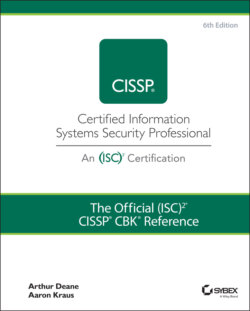Читать книгу The Official (ISC)2 CISSP CBK Reference - Leslie Fife, Aaron Kraus - Страница 37
Organizational Roles and Responsibilities
ОглавлениеPeople who don't work in security often look at security professionals as the only employees responsible for keeping systems and information secure. Of course, as information security professionals, we know that it is really everyone's job to keep the organization's assets and information secure — that means from the chief executive officer (CEO) down to the most junior clerk in the mailroom, and everyone in between. As a CISSP, one of your jobs is to evangelize security throughout your company, while helping to define security roles and responsibilities throughout the organization.
Your organization should define security roles and responsibilities within your information security policy, and it should align with roles and responsibilities defined in other organizational policies. It's important that roles and responsibilities are defined for and understood by employees of every level and line of business, as well as third parties such as contractors and vendors.
Different companies have different roles, but the following designations are some of the most commonly seen information security roles:
Chief information security officer (CISO): A CISO is the senior-level executive within an organization who is responsible for the overall management and supervision of the information security program. The CISO drives the organization's security strategy and vision and is ultimately responsible for the security of the company's systems and information. While corporate reporting structures vary by company size and industry, most CISOs now report to a company's chief information officer (CIO) or CEO.
Chief security officer (CSO): A CSO is a senior-level executive within an organization who is generally responsible for all physical security and personnel security matters. Many organizations have merged CSO responsibilities into the CISO role, but you should be aware of the potential distinction between the two. To make matters even more confusing, some organizations refer to their overall security leader as a CSO (instead of CISO). You should lean on context anytime you see these titles used.
Security analyst: A security analyst is someone with technical expertise in one or more security domains who executes the day-to-day security work. This may include things such as data analysis, firewall rule management, incident handling, and other operational activities.
Manager or program manager: In security, a manager (or program manager) is someone who owns one or more processes related to information security. A security manager may be the owner for compliance, vulnerability management, or any other broad set of responsibilities that are executed by security analysts.
Director: In security, a director is generally a manager of managers who is responsible for the overall strategic guidance of a group of security programs.
NOTE While the role of CISO has traditionally reported to a company's CIO, that trend is changing. Organizations increasingly view information security as not only an IT issue but a business issue. As a result, many argue that CISOs should report directly to a company's CEO.
As previously mentioned, security is everyone's responsibility. Outside of the information security roles and responsibilities described in the previous list, every user within an organization plays an important role in keeping information secure. A user (or end user) includes any person who accesses or handles an organization's information systems or data. Users may include full-time and part-time employees, interns, contractors, consultants, vendors, partners, and so on. Some general user responsibilities include the following:
Understand, agree to, and adhere to all information security policies, procedures, standards, and guidelines, as well as any relevant regulatory and compliance requirements. Users are also responsible for satisfying contractual obligations (such as nondisclosure agreements) that affect the confidentiality of the company's information and processes.
Complete all required information security training and awareness activities by their required completion dates.
Report any actual or suspected security violations or breaches to appropriate personnel in a timely manner.
